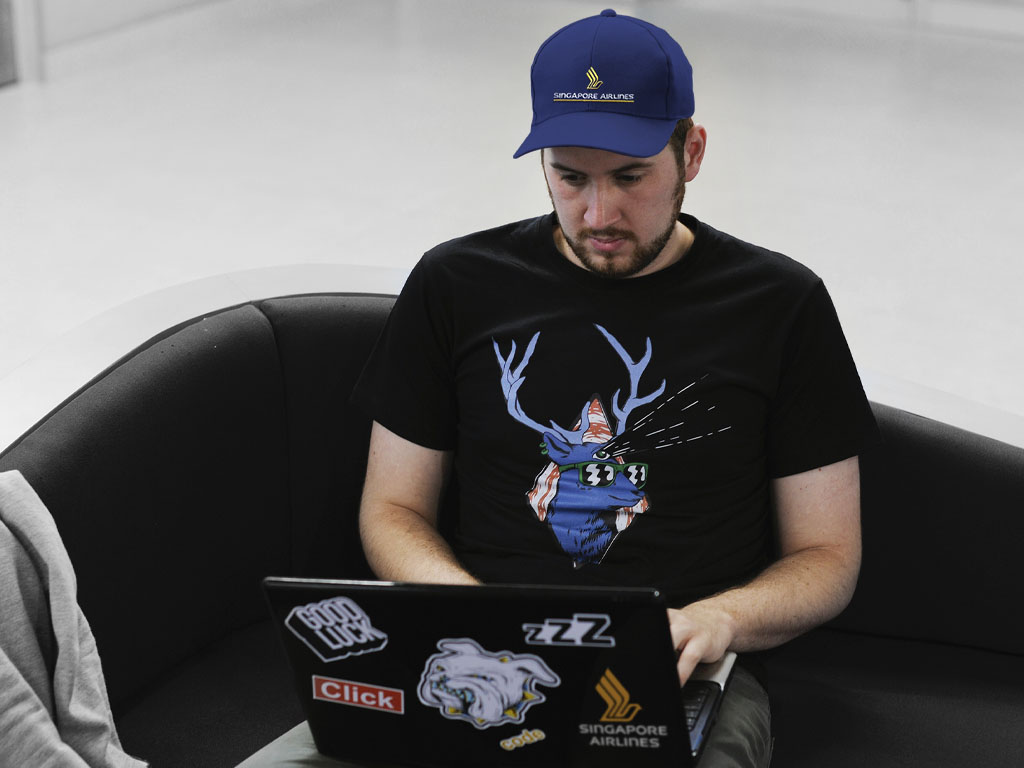When Alaska Airlines rolled out its free inflight access to popular messaging apps like iMessage, WhatsApp and Facebook Messenger, it did it with flair.
The airline created the #ChatOnAlaska hashtag for use on its social media marketing campaigns. Airline employees wearing emoji shirts greeted passengers at the gate and invited passengers to take photos with them for use on the airline’s social media channels. Once on the plane customers could choose their favorite of several emoji cookies.
The campaign illustrated how Alaska Airlines effectively brands itself on social media. More specifically, though, it demonstrated how the airline engages with its customers.
“Staying in touch with our customer base is extremely important,” says Andrew Harrison, Alaska Airlines’ Executive Vice-President and Chief Commercial Officer. “This campaign highlights one of the ways in which Alaska Airlines maintains a conversation with its customers. Flying with Alaska Airlines is more than just going from point A to point B. It is about having a tight-knit relationship with our consumers. Social media has allowed us to continually gauge their satisfaction.”
True to form, Alaska Airlines ranked high for its approach to social media engagement in a recent Engagement Labs ranking. The announcement of Alaska Airlines’ complimentary inflight messaging access came shortly after the acquisition of California-based Virgin America, an airline already known for its youthful, accessible and engaging social marketing campaigns.
The airline used the acquisition itself to launch a smartly timed and styled advertising and social campaign. Its “Different Works” campaign, as detailed by Adweek here, drove home to existing and potential customers that the unlikely pairing of the Alaska and Virgin airlines would be a merger worth betting on.

Alaska Airlines’ efforts are just one example of how airlines — and brands in general — are competing to capture people’s attention. Now is a time of experimental social and marketing strategies as brands seek to tap into the hivemind’s collective consciousness. Singapore Airlines, for example, made use of social media marketing principles to promote its newly redirected Houston–Singapore flight (now running through Manchester, U.K. instead of Moscow) on its A350s. It crafted a curious video ad showing fully outfitted American football players checking in to and boarding a flight; the airline shared it on Facebook, Instagram and Twitter.
Social Listening is Key
Content like Alaska and Singapore Airlines’ speaks to brands’ massive efforts to connect to consumers in a meaningful way. There’s more to it than making a cheeky ad or social post and hoping it gets shared, though. This is where social listening comes in.
According to Sprout Social, “Social listening is the process of tracking conversations around specific phrases, words or brands, and then leveraging them to discover opportunities or create content for those audiences.”
“One of the most important things an airline can do is have quality social listening mechanisms and software in the marketing/social media department”, says Regina Luttrell, associate professor of public relations and social media at Eastern Michigan University and author of Social Media: How to Engage, Share, and Connect.
“It is vital in this day and age to know who is re-tweeting something, who is sharing an image, who is commenting and who is direct messaging,” says Luttrell, who has worked with several Fortune 500 companies.
To do this effectively requires some effort on airlines’ part, of course. As Luttrell details, “Companies that have the resources should have a digital command center in which approximately 7 to 10 big-screen monitors are connected to a server and broadcast what is happening on the different platforms.”
“In addition, if an airline runs a television ad, the team is able to see what is happening across the social media channels and the company’s website. This live social dashboard allows the team to see how many people access the website while engaging through social media channels,” she continues.
Cathay Pacific does a tremendous job in utilizing social listening to better understand its customers. The managers of the airline’s Twitter account frequently retweet relevant and interesting information, which lets existing and potential customers know that they are aware of the world around them. The airline also makes use of the #LifeWellTravelled hashtag, inviting Twitter users to tweet about their travel experiences. The airline makes a point of replying to people who tweet at them in a timely fashion, whether it’s to respond to a complaint or enjoy a moment with the tweeter.
Turning Engagement Into Money
It’s all well and good to have social marketing campaigns that tap into the broader conversations customers are having, as well as current events — but how do airlines get a return on their social media investment?
“In a tightening economy, businesses need to make sure that they’re getting a return on their marketing investment,” writes Tia Fisher in the Journal of Database Marketing & Customer Strategy Management.
As Fisher notes, it is difficult to measure the value of social media and its return. Yet it’s also true that social media is a hugely powerful force when it comes to cultivating a positive brand sentiment — and how people feel about a company often informs whether they are likely to be a customer in the future.
“A customer is worth far more than their initial spend with your company: you need to factor in future purchases and the influence they may have through social media,” Fisher continues in the ROI in social media: A look at the arguments journal article.
The travel business in particular benefits from developing customer loyalty — and ultimately long-term relationships — with its clientele, and a smart social media strategy here can go a long way on this front. To this end, Luttrell says companies should stick to the 80/20 rule. As she writes on her website, “The premise behind the 80/20 rule is to post content that is relevant to your audience at least 80 percent of the time. That means content explicitly about your company or products should be posted no more than 20 percent of the time.”

In short, Luttrell tells Panasonic Avionics, “Don’t inundate the social media channels with promoted sales opportunities or coupons that come across as artificial in nature.”
That means picking your sales opportunities wisely. Singapore Airlines recently tweeted: “Is your power adapter ready for your vacation? Travel adapters are available for sale on the KrisShop onboard!” with photos related to the correct adapter. This is a good opportunity to generate ancillary revenue, but as Luttrell mentioned, it’s important to choose your sales pitches wisely. The majority of Singapore Airlines’ tweets are links to blog posts about travel destinations and other value-added content relevant to its customer base. It publishes these articles on the website of its proprietary travel magazine, SilverKris.
Ultimately, the dynamism of establishing a two-way relationship, in which the consumer finds enjoyment in following the brand’s social media channels, allows for a good value proposition to take shape.
“Having a blog like this develops the conversation in an organic way,” Luttrell says. “In addition, the effective use of hashtags unifies a conversation and illustrates how social media effectively operates.”
Delivering Content to Travelers
In addition to its inflight magazine, Singapore Airlines also has a standalone SilverKris app. For passengers who don’t want to get a special app just for the magazine, the airline also allows passengers to download editions of the inflight magazine as well as a suite of other publications with the main Singapore Airlines companion app, which was developed by Panasonic Avionics.
“Airlines have a huge following because of the nature of frequent flyers and repeat customers,” Luttrell says. “Showing passengers inflight what’s trending before they arrive to a particular destination enables airlines to be the guiding light that consumers trust, especially when it comes to hub centers of airlines.”
The Singaporean airline also delivers advertising and branded content via its seatback and mobile entertainment system, along with its premium entertainment offering that includes movies, games and its SilverKris travel content. Because of the physical placement of seatback IFE screens and the omnipotence of mobile devices, a multi-pronged delivery strategy aimed at engaging an already captive audience can help airlines to generate greater ad revenues and to develop fruitful partnerships with complementary brands.
Use Your Network
A company that not only nails its social media strategy, but also offers top-notch service to back up its hype, will often attract brand evangelists. These travelers can become “influencers” — people who use their own social media presence to boost brands. This is a whole other genre of marketing called influencer marketing, which embraces the notion that people like to receive word-of-mouth recommendations before they spend their money.
As social media management platform maker Hootsuite wrote late last year: “You probably know that word-of-mouth is one of the most valuable forms of marketing out there: It’s been shown to influence 20 to 50 percent of all purchasing decisions. After all, potential customers are much more likely to be receptive to recommendations from a person they respect and trust than to ads or other corporate messaging.”
Luttrell suggests using frequent passengers as influencers to help brand and market the airline. “While an effective social media strategy in house is extremely important, using people who fly on the airline for their own specific purpose goes a long way in driving the conversation,” Luttrell says.
This drives home the point that engagement has to be a two-way street in today’s online world — meaning that brands have to care just as much about the individual consumer as the consumer cares about the brand.
“Retweeting or liking posts by passengers resonates loudly because it shows the airline cares about its customer base,” says Luttrell. “When that happens, then the branding takes care of itself and it ultimately — and positively — affects the bottom line.”



